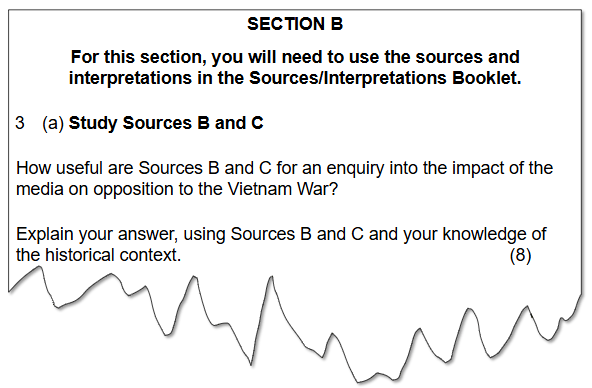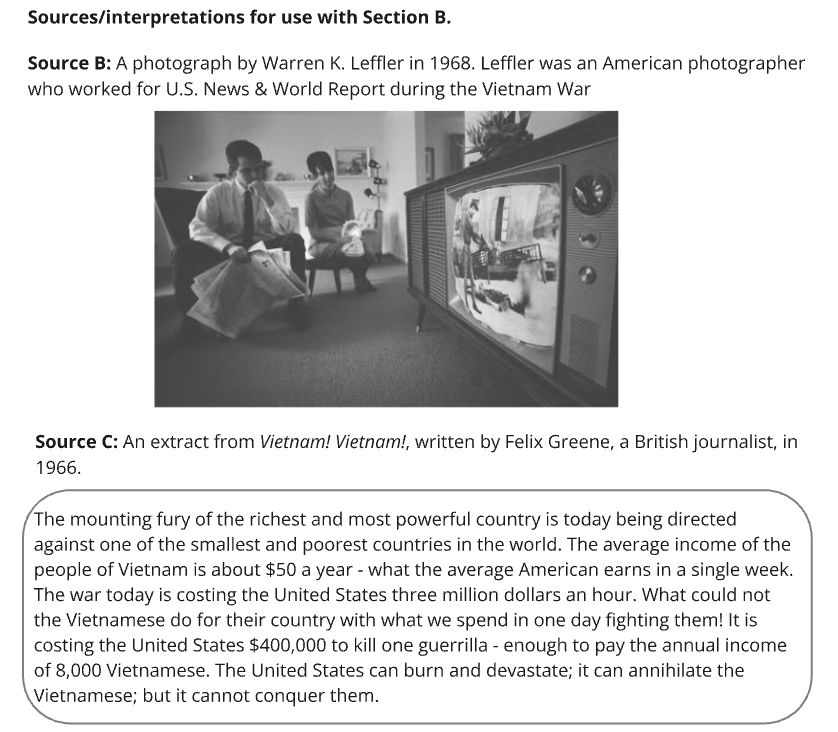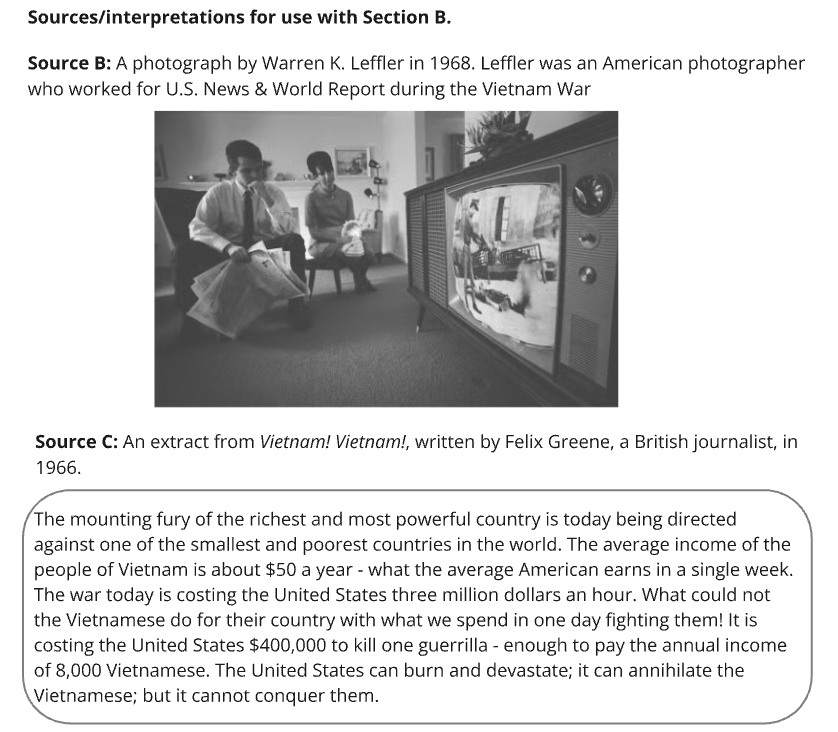The 8 Mark "How Useful Are Sources B and C" Question (Edexcel GCSE History): Revision Note
Exam code: 1HI0
Summary of Question 3 (a)
Question 3 (a) requires you to evaluate how useful two sources are for a historian investigating a specific issue
You should:
Refer to the content and provenance of the sources
Use relevant own knowledge to support your points
Make a clear judgement on how useful each source is for the enquiry
This is the first question in Section B of the paper
Questions 3 (a) to 3 (d) will be based on the same topic
Amount of marks | 8 |
|---|---|
The time that you should spend on the question | No more than 15 minutes 5 minutes of planning 10 minutes of writing |
An example of the type of question you may encounter can be seen below:

In previous years, this question has focused on the following topics in The USA, 1954–75:
Year of Exam | Question Topic |
|---|---|
2018 | The Tet Offensive on American attempts to win the Vietnam War (opens in a new tab) |
2019 | The achievements of the civil rights movement, 1960–65 (opens in a new tab) |
2020 | Reasons for the failure of the USA in Vietnam (opens in a new tab) |
2021 | The position of Black Americans in the 1950s (opens in a new tab) |
2022 | The methods used by the Black Panther movement (opens in a new tab) |
2023 | The Freedom Summer (1964) (opens in a new tab) |
2024 | The achievements of Martin Luther King in the civil rights movement |
What is a historical enquiry?
A historical enquiry is when historians ask questions, select evidence and make judgements about the past
All questions in Section B — Questions 3 (a) to 3 (d) — will be focused on the same historical enquiry
The enquiry could be based on either civil rights or the Vietnam War
If you do not link your answer to the enquiry in the question, you cannot score more than 2 marks
Using the content and provenance of a source
A historical source is made up of:
The provenance
The background of the source
The content
The information the source shows or describes
Provenance
The provenance appears at the top of each source and usually tells you:
Who created it
What type of source it is (e.g. a diary)
When it was produced
Where it was created
For the example question, here is a breakdown of the provenance of Source B:
Who | Warren K. Leffler |
|---|---|
What | A photograph |
When | 1968 |
Where | The USA |
How is provenance important for a "How useful…" question?
Use the provenance to consider:
Is the source typical of what you would expect the author to say or show?
Is the source accurate if it was produced years after the event?
What factors could have influenced their opinion?
Content
Finding the content of a source depends on the type of source you have
Written sources
Read the text closely to understand what it tells you about the issue in the question
Look for:
The author’s overall viewpoint on the enquiry
Key quotes about the enquiry
Visual sources
Look carefully at what the image shows
Ask yourself:
What is happening in the image?
Who or what is included or left out?
What message is being communicated?
Is anything staged or exaggerated?
How is content important for a "How useful…" question?
Use the content to:
Make inferences about the enquiry
Provide evidence for your judgement on the source's usefulness
Making judgements in a “How useful are Sources B and C?” question
The 8 mark "How useful” question requires you to make a judgement
Common mistakes in judgement questions
Saying that neither source is useful
Avoiding a clear decision by using phrases such as “kind of” or “maybe”
Focusing on reliability rather than usefulness
All sources are useful for a historian, but not all sources are reliable
A speech by Malcolm X is likely to be biased in favour of Black Power ideals
However, it tells historians about how civil rights activists communicated their beliefs to the public
What makes a good judgement?
Refers to specific content from the source
Uses the provenance clearly
Applies relevant contextual knowledge
Links back to the focus of the question
For the example question, the focus of the question is the impact of the media on opposition to the Vietnam War
The limitations of sources
Your judgement does not need to include limitations to get full marks
Students’ responses are often given higher marks if they only focus on the source's strengths
However, if you include a limitation, you must make sure the limitation is:
Supported by knowledge
Focused on the question
Relevant to your answer
"How useful are Sources B and C?" question structure
You will find Sources B and C in the Sources/ Interpretations Booklet
Do not use Source A for this question
This source is only relevant to Section A
It is not included in the insert

Your answer should include:
An explanation of how useful each source is for the enquiry
Use of content and provenance
Specific and accurate own knowledge
Your answer could be written in PEE paragraphs
P — Make a point about the question
Make it clear how useful the source is
Use the source to make an inference about the issue in the question
E — Use information from the source and knowledge to support the point you have made
Your knowledge should be specific
E — Explain why this shows that the source is useful
Focus on the given issue in the question
To get full marks, your judgement must use:
The source's content
The source's provenance
Your own knowledge
You will need two paragraphs
The focus of Paragraph 1 should be Source A
The focus of Paragraph 2 should be Source B
You will achieve 8 marks for your analysis and evaluation of how useful both sources are for the enquiry (S)
Worked example of a "How useful are Sources B and C?" question
Worked Example
3 (a) Study Sources B and C.
How useful are Sources B and C for an enquiry into the impact of the media on opposition to the Vietnam War?
Explain your answer, using Sources B and C and your knowledge of the historical context.
(8)

Answer:
Source B is useful for an enquiry into the media's impact on opposition to the Vietnam War because it shows how ordinary Americans were exposed to the war through daily TV broadcasts (S). In the photograph, we see a man and woman watching a disturbing image of a soldier with a gun and a dead body on the screen (S). From my own knowledge, I know that this was the first televised war, and scenes such as the execution of a Viet Cong prisoner in Saigon and the aftermath of the My Lai Massacre were shown on TV, shocking many Americans and increasing anti-war feelings (S). The source is useful because it was taken by Warren K. Leffler, an American photographer who worked for U.S. News & World Report. This was a mainstream national news company at the time. Therefore, the image reflects how many Americans were accessing the war through the media, making it a valuable source for understanding the media's impact on the US public (S).
Source C is also useful because it shows how journalists criticised the USA's actions in the war (S). Felix Greene writes that “The war today is costing the United States three million dollars an hour”, which suggests that the media was questioning the financial cost of the war to ordinary people (S). From my own knowledge, I know that journalists played an important role in turning people against the war. Magazines, newspapers and TV documentaries criticised the killing of civilians and the destruction of villages, which helped to change public opinion (S). Source C is less typical because it was written by a British journalist in 1966, not an American citizen. This might mean that he was less connected to public opinion in the USA. However, the source is still useful for showing the media's growing concerns over the government's handling of the war (S).

Unlock more, it's free!
Did this page help you?